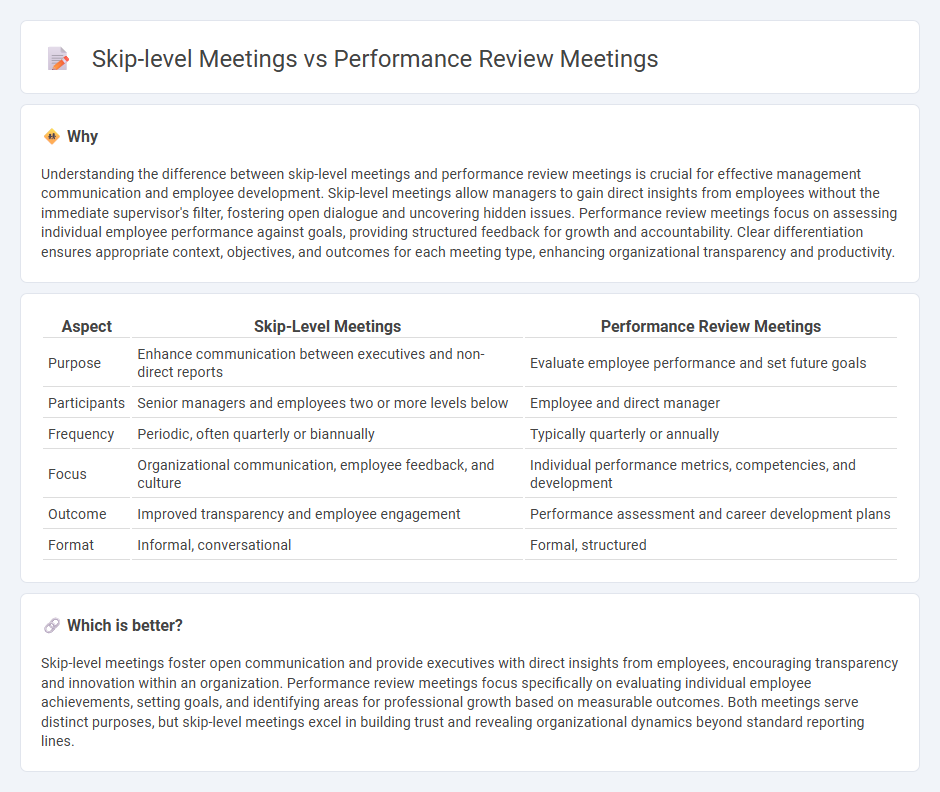
Skip-level meetings connect employees directly with higher-level managers, fostering open communication, uncovering workplace issues, and enhancing organizational transparency. Performance review meetings focus on evaluating individual employee achievements, setting goals, and providing constructive feedback to boost productivity and professional growth. Explore more about how these distinct meeting types optimize management effectiveness and employee engagement.
Why it is important
Understanding the difference between skip-level meetings and performance review meetings is crucial for effective management communication and employee development. Skip-level meetings allow managers to gain direct insights from employees without the immediate supervisor's filter, fostering open dialogue and uncovering hidden issues. Performance review meetings focus on assessing individual employee performance against goals, providing structured feedback for growth and accountability. Clear differentiation ensures appropriate context, objectives, and outcomes for each meeting type, enhancing organizational transparency and productivity.
Comparison Table
| Aspect | Skip-Level Meetings | Performance Review Meetings |
|---|---|---|
| Purpose | Enhance communication between executives and non-direct reports | Evaluate employee performance and set future goals |
| Participants | Senior managers and employees two or more levels below | Employee and direct manager |
| Frequency | Periodic, often quarterly or biannually | Typically quarterly or annually |
| Focus | Organizational communication, employee feedback, and culture | Individual performance metrics, competencies, and development |
| Outcome | Improved transparency and employee engagement | Performance assessment and career development plans |
| Format | Informal, conversational | Formal, structured |
Which is better?
Skip-level meetings foster open communication and provide executives with direct insights from employees, encouraging transparency and innovation within an organization. Performance review meetings focus specifically on evaluating individual employee achievements, setting goals, and identifying areas for professional growth based on measurable outcomes. Both meetings serve distinct purposes, but skip-level meetings excel in building trust and revealing organizational dynamics beyond standard reporting lines.
Connection
Skip-level meetings enhance management's understanding of employee performance by facilitating direct communication beyond immediate supervisors, which provides deeper insights during performance review meetings. These discussions help identify strengths, challenges, and development opportunities, ensuring performance evaluations are more accurate and actionable. By integrating skip-level feedback, organizations can align individual goals with broader strategic objectives, improving overall performance management.
Key Terms
**Performance Review Meetings:**
Performance review meetings concentrate on evaluating an employee's job performance, setting goals, and providing constructive feedback to enhance productivity and professional growth within a defined period. These meetings typically involve direct supervisors and employees discussing achievements, challenges, and areas for improvement aligned with organizational objectives. Explore more to understand how effective performance reviews can drive employee engagement and business success.
Feedback
Performance review meetings concentrate on evaluating an employee's achievements, strengths, and areas for improvement based on set objectives and competencies. Skip-level meetings facilitate direct feedback between employees and higher-level managers, bypassing immediate supervisors to foster open communication and identify organizational or team issues. Discover how leveraging both feedback channels can enhance team performance and employee development.
Goal Setting
Performance review meetings emphasize individual goal setting aligned with organizational objectives, allowing managers to evaluate past achievements and define future targets. Skip-level meetings foster direct communication between higher-level leaders and employees, promoting transparency and aligning personal goals with broader company vision. Discover how integrating both approaches can enhance effective goal setting across your organization.
Source and External Links
How to Conduct a Performance Review Meeting: A Manager's Guide - A step-by-step guide details how to structure a performance review meeting, including setting a positive tone, reviewing goals and achievements, discussing feedback, setting new objectives, creating development plans, inviting employee input, and agreeing on action steps and next review date.
Six Helpful Tips on How to Conduct a Performance Review Meeting - Emphasizes preparation, outlining a clear purpose and agenda, involving employees by asking for their input and goals, and ensuring the conversation is a two-way dialogue rather than a one-sided assessment.
Tips on how to handle a performance review meeting - Workleap - Stresses the importance of a standardized, clear process for all employees, using specific examples and data, and walking employees through the process to ensure comfort and fairness.
 dowidth.com
dowidth.com